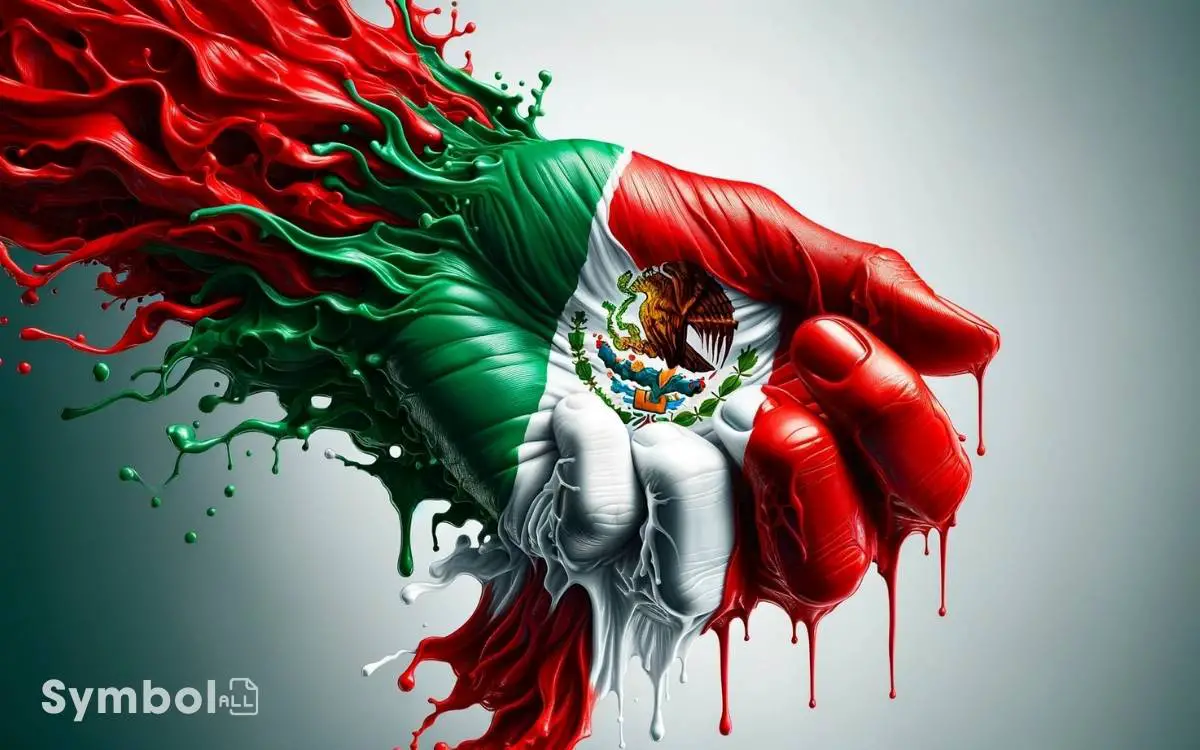What Do the Colors of the Mexican Flag Symbolize? Explained!
The colors of the Mexican flag—green, white, and red—aren’t just chosen at random. Adopted in 1821, they embody the nation’s spirit and its history. You’ve got green symbolizing Mexico’s lush lands and its drive for freedom.
White stands for the peace and unity binding the country. Red reflects the sacrifice and blood of those who fought for Mexico’s sovereignty.
These colors aren’t just about the past; they’re a confirmation to the resilience and hope that define the nation’s identity.
Understanding the depth of these symbols offers a glimpse into Mexico’s vibrant culture and the unity that powers its future.

Key Takeaway
Historical Origins
Tracing the historical origins of the Mexican flag’s colors reveals a complex tapestry of political, religious, and cultural influences that have shaped the nation’s identity.
Initially, these colors were adopted by the Army of the Three Guarantees in 1821, symbolizing independence from Spanish rule.
The choice of colors wasn’t arbitrary; each shade was imbued with significance reflective of the nation’s aspirations and values.
Red and white, beyond their association with the Virgin of Guadalupe, echoed the colors of the national liberation army, signifying unity and the blood of national heroes.
Over time, these colors have been reinterpreted, yet their origins remain a proof of Mexico’s enduring struggle for sovereignty and the complex layers of its national identity.
The Color Green
While the red and white of the Mexican flag have their own storied histories, the color green carries its own rich symbolism, deeply rooted in the nation’s aspirations for independence and hope.
You’ll find that the green stripe, positioned on the hoist side, isn’t merely a decorative element. It’s emblematic of the fertile land of Mexico, but more profoundly, it represents the nation’s quest for freedom and the hope that fueled the struggle for independence.
This color’s presence on the flag is a constant reminder of the sacrifices made for liberty and the ongoing commitment to a future filled with prosperity.
Analyzing the green through this lens, you grasp a deeper appreciation for the flag’s design, acknowledging it as a symbol of the enduring spirit of the Mexican people.
Symbolism of White
In exploring the Mexican flag, the white stripe stands as a powerful symbol of peace and unity, reflecting the core values that bind the nation together.
This central band, prominently positioned, conveys a profound message of harmony amidst diversity. It’s a reminder of the country’s ongoing quest for internal concord and the aspiration towards a cohesive society.
The white stripe serves not just as a visual break between the vibrant green and red but as a narrative space where the ideals of peace are visually communicated.
In the heart of this stripe lies the national coat of arms, further enriching its significance by embedding the nation’s identity within a context of tranquility and solidarity.
The white, hence, isn’t merely a color; it’s a canvas narrating Mexico’s commitment to unity and peace.
Significance of Red
As you turn your attention to the red stripe on the Mexican flag, you’re engaging with a powerful emblem of sacrifice and resilience.
This color commemorates the blood of national heroes who laid down their lives during Mexico’s arduous struggle for independence.
It’s a vivid reminder that freedom wasn’t freely given but was fought for with unwavering courage and determination.
Blood of National Heroes
The red stripe on the Mexican flag stands as a profound tribute to the blood shed by national heroes who fought valiantly for their country’s freedom and sovereignty.
This element of the flag isn’t just a color; it’s a narrative woven into the fabric of Mexico’s history, representing the ultimate sacrifices made by those who believed in the vision of an independent and sovereign nation.
It’s a reminder that the liberties enjoyed today were hard-won, paid for with the lives of individuals who stood against oppression and injustice.
When you look at the red section, it’s an invitation to reflect on the courage, the struggles, and the enduring spirit of those who laid down their lives, ensuring their legacy in the nation’s collective memory and identity.
Struggle for Independence
Considering Mexico’s struggle for independence, it’s crucial to grasp that the red in its flag symbolizes more than just a color; it embodies the profound sacrifices made during a tumultuous period marked by a fierce fight for sovereignty.
This hue captures the essence of resilience and valor, representing not only the blood shed by the nation’s heroes but also the collective spirit of a people determined to carve their destiny.
The red stripe serves as a constant reminder of the battles fought, lives lost, and the unyielding determination that fueled Mexico’s path to independence.
It’s a symbol of the courage and sacrifice embedded in the national identity, urging you to explore further into the historical context that shapes the present.
The National Coat of Arms
At the heart of the Mexican flag lies its national coat of arms, a symbol steeped in history and rich in meaning.
This emblem, centered against a white backdrop, portrays an eagle perched on a prickly pear cactus, devouring a serpent.
This imagery isn’t merely decorative; it’s a narrative deeply rooted in Aztec mythology, signifying the founding of Tenochtitlán, the heart of the Aztec empire, and present-day Mexico City.
The cactus and the rock it sits upon are thought to symbolize strength and endurance, while the eagle and serpent represent good triumphing over evil.
The coat of arms serves as a visual reminder of Mexico’s indigenous heritage and the enduring spirit of its people, encapsulating the nation’s identity and aspirations.
Changes Over Time
You’ve observed how the National Coat of Arms occupies a central position in the Mexican flag’s identity, but it’s important to understand how its design and the flag’s colors have evolved over time.
This transformation wasn’t merely aesthetic; it reflected shifts in political, social, and cultural landscapes, impacting symbolic color interpretations.
Evolution of Flag Design
The Mexican flag has undergone several transformations since its inception, each reflecting shifts in the nation’s identity and political landscape.
- 1812-1821: The initial flag was born out of the War of Independence, symbolizing the struggle for freedom from Spanish rule.
- 1821-1968: Various iterations were introduced, often tweaking the emblem at the center to reflect the country’s evolving political and social ethos.
- 1968-Present: The current design was standardized, focusing on precise symbolism and dimensions to foster national unity.
These changes highlight how the flag’s design has been a mirror to Mexico’s tumultuous and vibrant history. You’ve seen it adapt to the times, embodying the spirit and values of its people while maintaining its core symbols.
Symbolic Color Interpretations
Exploring how the colors of the Mexican flag have evolved offers insight into the nation’s shifting values and ideologies over time.
Initially, the green represented independence from Spain, white symbolized the Catholic faith, and red stood for the union between Europeans and Americans.
However, as Mexico’s political and social landscape transformed, so did the meanings of these colors. Today, green signifies hope and prosperity, white embodies peace and unity, and red reflects the blood of national heroes who fought for Mexico’s freedom.
This shift underscores Mexico’s journey towards a secular, inclusive society, moving away from colonial legacies towards a future built on the sacrifice and aspirations of its people.
It’s a demonstration to the dynamic nature of cultural symbols, adapting to mirror the evolving heart of a nation.
Independence and Hope
Green, one of the primary colors on the Mexican flag, symbolizes the nation’s pursuit of independence and the hope that fueled this struggle.
This vibrant hue encapsulates a significant period in Mexico’s history, where the desire for autonomy and a brighter future were paramount.
- Historical Context: Green reflects the early 19th-century movement towards independence from Spanish rule.
- Symbol of Hope: Represents the optimism of the Mexican people for a self-determined future.
- Revolutionary Spirit: Embodies the courage and determination of those who fought for freedom.
- National Identity: Integral in fostering a sense of pride and unity among Mexicans.
- Future Aspirations: Continues to inspire the pursuit of progress and equity in modern Mexico.
Analyzing the green in the Mexican flag reveals deep layers of historical significance and a collective aspiration for a better tomorrow.
Unity and Faith
You’ll find the essence of unity and faith in the Mexican flag’s colors, reflecting not just aesthetic choices but profound historical and cultural significance.
The symbolic national colors serve as a reminder of the country’s historical unity roots, binding its people across generations.
Additionally, these hues embody a collective faith in the future, signifying a shared belief in progress and harmony.
Symbolic National Colors
Often, the colors of a nation’s flag are imbued with deep symbolic meanings that reflect the core values and principles of its people, and in the case of Mexico, the green, white, and red hues symbolize unity and faith among its citizens. These symbolic representations are not unique to Mexico, as many other nations also infuse their flags with profound meaning. For example, the colors of the French flag—blue, white, and red—stand for liberty, equality, and fraternity, ideals born out of the French Revolution. Such colors not only serve as national identifiers but also act as reminders of the values and struggles that shaped a country’s identity.
These colors don’t only adorn the flag but also weave together the fabric of Mexican identity, emphasizing the importance of:
- Green: Hope and prosperity, encouraging a forward-looking optimism.
- White: Purity and peace, serving as a reminder of the importance of maintaining integrity and harmony within society.
- Red: The blood of national heroes, underscoring the sacrifices made for freedom and sovereignty.
- Unity: A collective identity, fostering a sense of belonging and solidarity.
- Faith: The enduring belief in the nation’s values, inspiring trust and confidence in its path forward.
Historical Unity Roots
Delving into the historical unity roots of Mexico, it’s important to understand how shared struggles and triumphs have cemented a collective identity, intertwining faith and unity at the nation’s core.
| Event | Significance |
|---|---|
| War of Independence | Marked the birth of a unified national identity against Spanish rule. |
| The Reform War | Highlighted the struggle for liberal ideals, reinforcing unity against conservatism. |
| The Mexican Revolution | United various factions in the quest for justice and land reform. |
| Cristero War | Embodied the complex relationship between faith and state, challenging and ultimately reinforcing national unity. |
Through these pivotal moments, you grasp how Mexico’s storied past has fortified a collective identity, deeply rooted in the interplay of unity and faith.
Faith in Future
Reflecting on these historical milestones underscores the importance of keeping faith in the future, as unity and faith continue to shape Mexico’s societal fabric.
The colors of the Mexican flag aren’t just relics of the past; they’re beacons for the future, symbolizing the nation’s ongoing journey towards unity and collective belief in a better tomorrow.
- Green: Hope and prosperity, guiding the nation’s forward momentum.
- White: Peace and unity, essential for a harmonious society.
- Red: Blood of national heroes, reminding us of sacrifices for freedom.
- Coat of Arms: National identity and independence, anchoring faith in the nation’s path.
- Eagle and Snake: Mythological roots, symbolizing the strength found in unity and faith.
These elements combine to create a powerful narrative of resilience and optimism.
Strength and Bloodshed
The red in the Mexican flag symbolizes the strength and bloodshed of the nation’s heroes, marking pivotal moments in its fight for independence and unity.
This color serves as a powerful reminder of the sacrifices made by individuals who believed fervently in the cause of freedom.
Throughout Mexico’s tumultuous history, from the early struggles against colonial rule to the internal conflicts that shaped its modern identity, red has been a constant representation of the resilience and courage displayed by its people.
It’s not merely a tribute to past battles; it encapsulates the ongoing spirit of determination that drives Mexico forward.
This aspect of the flag invites you to reflect on the profound cost of liberty and the enduring strength that unites a nation.
Cultural Impact
Mexican flag colors weave deeply into the nation’s cultural fabric, influencing art, celebrations, and national identity with their rich symbolism and historical significance. You’ll see these colors not just on the flag but permeating various aspects of Mexican life.
- Art: Artists incorporate the flag’s colors to evoke national pride and reflect on the country’s struggles and triumphs.
- Festivals: From the vibrant parades of Independence Day to local celebrations, the flag’s colors are omnipresent, symbolizing unity and heritage.
- Fashion: Traditional and contemporary Mexican fashion often features the flag’s colors, celebrating identity and cultural pride.
- Cuisine: Even the country’s food presentation mimics these colors, offering a feast for the eyes and connecting culinary traditions to national symbols.
- Architecture: Buildings and public spaces frequently sport the flag’s colors, embedding national pride into the urban landscape.
Global Recognition
Globally, the vivid colors of Mexico’s flag have come to symbolize not only the nation itself but also its influential cultural heritage and enduring spirit, resonating well beyond its borders.
You’ll find the flag’s colors representing Mexico in international events, from sports to diplomatic meetings, showcasing its global presence and significance.
| Aspect | Green | White | Red |
|---|---|---|---|
| Symbolism | Hope & Prosperity | Unity & Purity | Sacrifice & Courage |
| Global View | Environmental Initiatives | Peace Efforts | Vibrancy & Passion |
| Cultural Influence | Culinary Richness | Architectural Beauty | Lively Traditions |
| Recognition | Economic Growth | Diplomatic Identity | Historical Struggle |
These elements highlight the deep meanings the flag’s colors carry, resonating with people worldwide, and fostering a sense of respect and admiration towards Mexico’s rich cultural tapestry and its contributions to global heritage.
Conclusion
In sum, you’ve journeyed through the vibrant vicissitudes of the Mexican flag’s colors, each hue harboring its own historical heartbeat.
Green glistens with hope, white whispers tales of unity, while red recalls the resilience and bloodshed of past battles.
This tricolor tapestry, teeming with tales, isn’t just a flag; it’s a fervent symbol of Mexico’s spirited saga. Its global gravitas garners admiration, anchoring it as an emblem of endurance and emblematic essence in the world’s eye.






